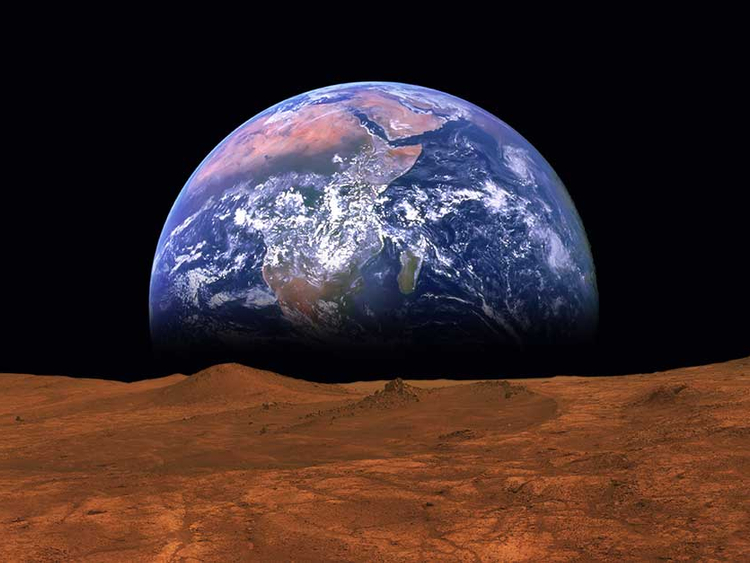DUBAI: The UAE has set its sights on building a colony on Mars, with a target date of 2117.
While it’s still a century away, the project is ambitious, and will need to harness all of the existing expertise of a range of international and scientific research organisations and institutes and ensure they collaborate together to get to the Red Planet and build a sustainable city for humans.
“Human ambitions have no limits, and whoever looks to the scientific breakthroughs in the current century believes that human abilities can realise the most important human dream,” said His Highness Shaikh Mohammad Bin Rashid Al Maktoum, Vice-President and Prime Minister of the UAE and Ruler of Dubai.
He announced the plan on the sidelines of the World Government Summit in Dubai on Tuesday evening.

“The new project is a seed that we are planting today, and we expect the next generations to reap its fruits,” he said.
But what will it take to get us to Mars and allow us to live and thrive there?
It’s an unprecedented scientific, engineering, aerospace and physical challenge that will require us to harness technologies and expertise — and funding — to reach the goal.
But we’ve set foot on the Moon — and did so within the decade deadline laid down by US President John F. Kennedy, with Neil Armstrong placing a human footprint on Tranquility Bay on July 20, 1969.
But there’s a big difference between a 10-day mission to the Moon that’s just 385,000 kilometres away and getting to Mars — 54.6 million kilometres away when it’s at its closest point to Earth. The journey alone would take between six and nine months — a huge physical endurance for our bodies in a zero-gravity environment.
But when we sent missions to the Moon five decades ago, the space capsules carried as much computing power as you’ll find now in a pocket calculator. And back then, no one could have predicted the technological, scientific, medical and artificial intelligence advances we enjoy today. Fast forward that rate of change for the next 100 years, and the sky — and the stars — are the limit.
“The 2117 Mars initiative is a long-term project, which will first help develop our education, universities and research centres that will empower young Emiratis to enter all disciplines of scientific research fields,” said His Highness Shaikh Mohammad Bin Zayed Al Nahyan, Abu Dhabi Crown Prince and Deputy Supreme Commander of the UAE Armed Forces, on Tuesday.
Perhaps, the man with the greatest knowledge of exactly what it will take to colonise Mars is tech billionaire Elon Musk. As well as developing Tesla performance electric cars, he’s the founder and driver of SpaceX. The private company is developing a massive rocket and capsule to transport large numbers of people and cargo to Mars with the ultimate goal of colonising the planet. And he was in Dubai, also speaking at the World Government Summit this week.
SpaceX has a 20-year lease on the same Nasa launch pads at Cape Canaveral in Florida used by the Apollo crews that went to the Moon, and successfully test fired a more powerful rocket engine there on Sunday. It was an important moment for the company, having had technical glitches that initially thwarted its aim of developing reusable rocket modules. Those have been overcome, with the last two launches and landings going as planned.
SpaceX intends to fly to Mars about every 26 months when Earth and Mars are favourably aligned. Musk said he would like to launch the first crew as early as 2024, a schedule he said was optimistic.
Musk, the founder of internet payment portal PayPal, said there would be no guarantee of survival for anyone signing up with SpaceX for the “incredible adventure” of a trip to Mars.
“The risk of fatality will be high. There’s no way around it. Basically, are you prepared to die, and if that’s OK then you’re a candidate for going,” he said at a presentation at the International Astro-nautical Congress meeting in Guadalajara, capital city of the Mexican state of Jalisco, last year.
Though Musk said he envisions humans living in a large colony on Mars and possibly terraforming the planet, he added that one key issue will be getting the cost low enough to attract customers.
“You can’t create a self-sustaining civilisation if the ticket price is $10 billion per person,” he said. “Our goal is to get it roughly equivalent to (the) cost of a median house in the United States, about $200,000.”
Mars colonists would not have to sign up for a one-way journey since reusing the spaceships keeping the transportation costs low, Musk said.
“The number of people willing to move to Mars is much greater if they have the option of returning, even if they never do,” he said.
Musk said it would be a challenge to fund the Mars effort, with development costs estimated at $10 billion. “I’m personally accumulating assets in order to fund this,” he said, adding that “ultimately this is going to be a huge public-private partnership.”
SpaceX, which Musk founded specifically with the purpose of colonising Mars, is one of several private and government-funded ventures vying to put people and cargo on the Red Planet and other destinations beyond Earth’s orbit.
Landing the first humans there, after what traditionally has been a six- to nine-month journey, is an extremely ambitious goal. Musk expects his rocket to be able to cut the transit time to as little as three months.
The US government is also stepping up efforts to venture beyond the moon. And China has said it wants to land on Mars. The European Space Agency has suffered a series of setbacks in its aim of landing on our nearest neighbour.
Nasa is supporting SpaceX’s first mission to Mars, which is targeted for launch in 2018. SpaceX wants to send an unmanned capsule, called Red Dragon, to the surface of Mars to test descent, entry and landing systems.
Nasa will be providing deep-space and Mars communications relays for SpaceX and consulting services in exchange for flight data. Nasa wants to be able to land payloads weighing up to about 30 tonnes on Mars. So far, the heaviest vehicle to land on Mars was the one-tonne Curiosity rover.
SpaceX has a backlog of more than 70 missions for commercial and government customers, worth more than $10 billion.










